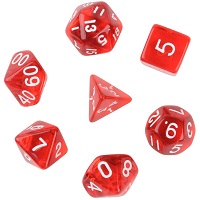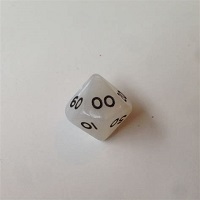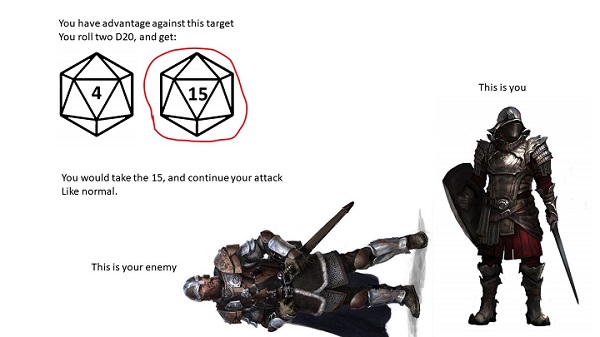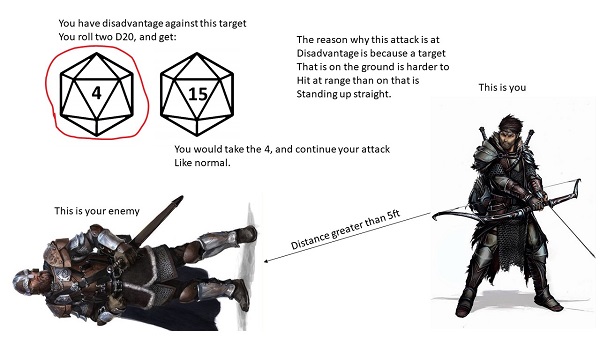Disclaimer: I do not own ANY image that shows up on this page, however as this is hosted for free use, with the intent of teaching, this likely falls under fair use.
Alright, so it looks like you decided to take a look at how to play the game. Well lets start with what the dice actually look like shall we? the image to the right depicts every single die that can be used (normally) within the game of D&D. But the one you will use the most is the D20.
Link to image
The D20 is this die right here, and it is used for almost every action that calls for a roll. examples include, "I want to break down the door", "I want to steal the coin bag on the table", and "I want to bash his head in", that last one "technically" won't ever happen because of health totals, but it would usually still trigger you to attack. Sometimes the DM, which is short for dungeon master will ask you to roll without you doing anything, such as rolling to excape a trap or to resist being pushed down. These types of rolls are usually saves, which I will talk about down the line.
Link to image
The rest of the dice is usually used when doing things like dealing damage, for instance the longsword has you do 1d8 damage, which uses this die right here.
Link to image
The rest are as follows, D12:
Link to image
D10:
Now you may have noticed that there is a 0 printed on it, when you roll a 0 that means you actually rolled a 10.

D6:
Link to image
D4:
By the way, the number you rolled is the number on the top.

and the last special case the D100:
Now this one is special because it is only ever rolled along with the D10. this makes up the tens for the D100. but you might be thinking to yourself, well how are you supposed to get 100 then? well it's simply that if you roll 00 on this die and 0 on the D10 you actually get 100

So that's cool and all but what do I do to actually make an attack, or attempt an action? Well, as I said earlier you need to roll the D20, so lets assume you're attempting to push open a door but its barred and is going to be difficult to do. This is a point when your DM will say something along the lines of "alright, roll me a strength check." That small sentence means a hell of a lot, so lets unpack it. lets start with the definition of check; A check in D&D is a non-attacking action that requires a roll of a D20. so check means to roll your D20. but then the other part of that is the word "strength". This means you want to look at the bonus on your character sheet to add (or subtract) a number to your roll. If you want to learn more about how the character attributes work I suggest taking a look at my guide on how to create a character.
Anyways, back to the scenario. lets say you have a +3 in your strength, and you roll you die, it lands on the side labeled 14, you would then add your bonus of +3 to that roll resulting in the number 17. At this point you would tell your DM "I rolled a 17." the DM then decided, based on a pre-defined difficulty number whether you succeed or not. This number is named the difficulty class, or DC for short. most of the time, only the DM knows what the roll needed was and it really is just, is the number you rolled + your bonus less than the number to meet/beat? if so you fail, otherwise you pass. lets say in this case the DC for the check was 15. here, you would succeed and the DM sould say something along the lines of "You manage to break the bar holding the door shut, it is now open."
But there are technically two more types of rolls you can make, attacks and skill checks. Lets look at skill checks as they are similar in nature to the above. The only difference is that you look for the bonus you have in a given skill, which I explain more in depth in my "how to build a D&D character" guide. looking at the same scenario, you want to break open a barred door. the DM says "Can I get an Athletics Check?" which asks you to roll a D20 and add that total to your bonus (which can be negative) in your athletics skill. Lets say your athletics is +5 because you have some proficiency in it. now you roll gets a +5 vs the +3 you got earlier. so lets say this time, however, you rolled poorly, getting only a 6 on the die. even with your superior bonus of +5 you only manage an 11 total. In this case the DM would likely say "you don't manage to break the bar holding the door in place. It still is holding strong."
So now that you have an understanding of checks, lets talk about saves. saves are much like checks in that you start by rolling a D20. the difference is where your bonus comes from. Every class in 5e has these proficiencies called save bonus. they differ between classes and are insanely helpful. for example if you are a fighter you have the save proficiency of strength and constitution. this means you get to add a bonus higher than the your stat. so if your DM tells you "make me a CON save" you would roll your D20 and add whatever bonus is listed under your CON save, which lets say in this scenario is +5, vs your CON mod of +3. So, you would just add 5 instead of 3.
The last type, attacking, is more involved and usually is done while in combat. this one goes kind of like this "I want to attack the goblin that is in front of me." and the DM responds "ok make an attack." an attack always starts the same way as all other rolls, roll a D20. Then you would want to add a bonus to your attack that is defined by your attacks. It usually follows the formula D20 + attacking stat(usually strength)+ proficiency bonus (provided that you have proficiency with that weapon). but the biggest difference is that it is against the specific creature your attacking. this time you are rolling against an Armor Class, known by most as AC. if you meet or beat the AC of the creature your attacking you hit. if you hit you go to roll your damage. The dice you roll, both the amount and the type are defined by your weapon.
So, lets say you hit the goblin you are attacking. You now need to roll your damage dice. This is defined by the weapon or spell you are using at the time. In this case you are using a longsword and you have a +3 to strength, which is your attacking stat. the calculation for how much damage you do is whatever the weapon has you roll + your attacking stat bonus, which in this case is 1D8 + 3. So, you roll a 5 on the D8 making your total damage dealt 8.
But there is a special rule in place for attacks like these. Known as the critical system, if you roll a 20 on the die without bonuses you crit, and if you roll a 1, you automatically fail to hit. what happens when you crit? well you double the amount of dice you were to roll. so if you crit on the goblin you would deal 2D8 + 3 instead of 1D8 + 3. that means you can potentially deal double the damage you would have.
the last thing I need to talk about is the advantage and disadvantage system. This is a bit tough so I'm going to show it in action using scenarios you might see come up. Alright, so first lets look at advantage. All it means is that roll two D20's instead of one and take the higher result. so for instance, you are attempting to attack somebody who is prone, on the ground. you would get advantage here so you roll two dice. you take the higher of the two, and continue with the attack as if you rolled only that one die.
Link to enemy Link to you Link to d20 template
Now lets modify that situation to make a disadvantageous one. lets say you want to use a ranged attack instead of melee. here, you would have disadvantage, which means roll 2D20 and take the lower result. you just continue the attack like normal after that.
Link to you
Well there you go, this is everything that is needed to get started with actually rolling dice. There is a lot more I won't be covering here but don't worry, your DM should be able to help you with those as they come up in game.